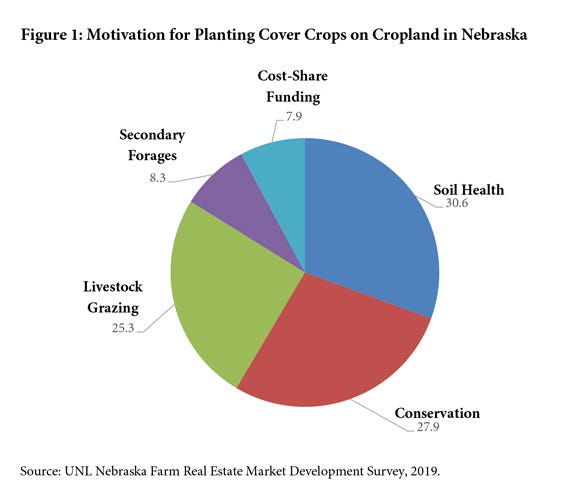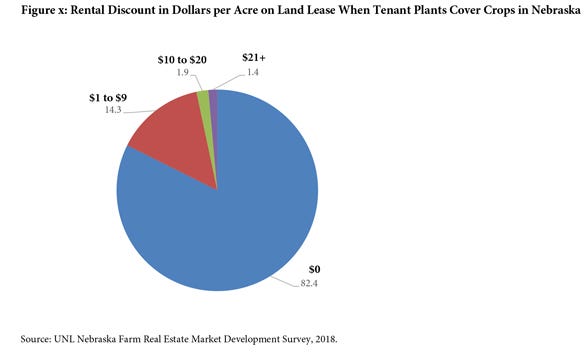
According to the 2017 Census of Agriculture, Nebraska increased its number of acres under no-till by nearly 1 million — going from 9,360,482 to 10,256,995 from 2012 to 2017. Meanwhile, cover crop acres more than doubled from 2012 to 2017 — going from 357,264 to 747,903. Farms planting cover crops rose from 2,826 to 4,419.
Of course, the motivation for planting cover crops varies from farm to farm. As part of the Nebraska Farm Real Estate Market Survey and Report 2018-19 special feature section, panel members — including experts in agribusinesses and the ag real estate industry — were surveyed on different motivations and considerations for cover crop use in Nebraska, and implications on cropland lease arrangements.
Based on panel responses, the biggest reason for planting cover crops was soil health at 30.6%, followed by a not entirely unrelated category, conservation, at 27.9%. This was followed by livestock grazing at 25.3%, secondary forages at 8.3%, and lastly, cost-share funding at 7.9%.

So, when planting a cover crop, what implications are there for land lease arrangements? Should landowners provide a discounted rent for tenants? For this survey, 82.4% of the panel members reported no rent discount for tenants planting cover crops. Meanwhile, 14.3% reported discounts of $1 to $9 per acre, only 1.9% reported discounts of $10 to $20 per acre, and even fewer, 1.4%, reported discounts of $21 or more per acre.
"Landowners need to take into account the long-term benefits of cover crop practices on their properties," says Jim Jansen, Nebraska Extension agricultural economist and one of the authors of the report. “According to survey results, we didn't see a large percentage of participants that provide a discount for some of these practices.
“That said, landowners need to take a closer look at understanding what tenants are doing in cover crops. The benefit on the short term may include reducing erosion. In the long run, it might increase soil organic matter and nutrient availability, where nutrients are kept from transitioning into a state that may not be accessible by plants or cause environmental issues."

Landlords may share in the cost of the seed and fertilizer. In the case of a crop share arrangement, the establishment expenses may be divided in proportion of the share.
"When it comes to a cash lease, that's where we really need to maybe take a look at providing a discount, because this is not just short-term but maybe long-term benefits, and the tenant may not realize the full benefits in one year alone," Jansen adds. "This is a good negotiation point for a tenant to discuss as part of lease negotiation."
Although not discussed in the survey, there may be an opportunity to sublease cover crop acres for some form of a secondary forage, depending on the circumstances the cover crops were established under. However, this would need to be negotiated as part of the land lease arrangement, and the method for dividing of any additional rental income from the sublease between the landlord and tenant.
It's also important to check with your crop insurance agent or local USDA Natural Resources Conservation Service representative to ensure compliance with any cost-share or disaster-related program payments.
"Depending on the circumstances, the producer may not have the option to consider utilizing the cover crop as secondary forage, whether by use with livestock or cutting for hay and bailing or chopping," Jansen says. "You might need to account for those factors, but this may be a way to partially offset the establishment costs of this practice."
About the Author(s)
You May Also Like






